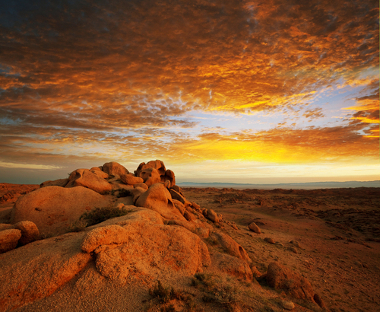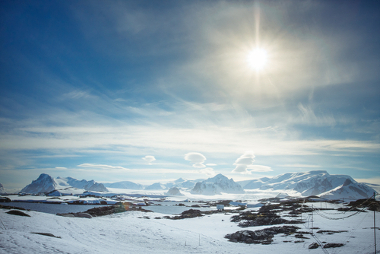You deserts they are regions that present few conditions for the maintenance of life, especially in terms of preventing or hindering human habitation. These are arid (but not necessarily hot) regions, with low rainfall and with few readily available food resources. But this does not mean that these locations do not have fauna, flora and even cities in their landscapes.
The word comes from the Latin “deserted”, which means uninhabited, lonely, emptied. Check below a list of the five main deserts in the world, with some of their main characteristics.
5th – Kalahari Desert (930,000 km²)

Kalahari Desert Landscape
The Kalahari Desert is the second largest in Africa, is located in the south of that continent and comprises the territories of Botswana, South Africa, Angola, Namibia, Zambia and Zimbabwe. Its extension of 930 thousand km² involves its fixed area and its transition zone, where there is a greater presence of animal and plant life. If we consider only its central zone, its area becomes “only” 580 thousand km².
The Kalahari is considered a “treacherous” desert because, for a short period of the year, there are some rains that help to flourish and transform the environment. The place, previously dry and without living conditions, is filled with vegetation and resources for food, acquiring a landscape that is nothing like that of any other desert. The problem is that, soon after, the drought and the harsh environment return and, if someone has been lost there, they may not survive due to the sudden depletion of water and food.
Despite these conditions, the Kalahari is home to some African tribal groups that have developed ways to survive there, some of them not even having contact with humans.
4th Gobi Desert (1,125,000 km²)

Sunset in the Gobi Desert
The Gobi Desert is in Asia, more precisely in the northern region of China and in the southern portion of Mongolia. The word “Gobi” comes from the Mongolian language and means “place without water”, having a relief marked by dunes and some rocky mountains.
Unlike the Kalahari, which has a relatively diverse fauna and flora, in Gobi, living beings are rare and of a few different types. Also in this desert it is possible to find some human populations, all nomadic.
3rd Arabian Desert (1,300,000 km²)
Also located in Asia, the Arabian Desert is located in the Middle East region, involving the territories of Saudi Arabia, Syria, Jordan, Iraq, Oman, Kuwait and Yemen. It is one of the areas with the lowest biodiversity on the planet.
However, this desert has many mineral resources, with emphasis on Petroleum, which, in this region of the Middle East, is present in the largest quantities on the planet. In terms of populations, there are peoples – some of them nomadic – Syrians, Kurds, Turks, Armenians and Assyrians.
The most striking feature of this desert is, without a doubt, the constructions carried out in it. The highlight goes to the supercity of King Abdullah (in reference to the name of the Saudi king), which is scheduled to be completed in 2020 and should initially house around two million inhabitants.
King Abdullah, a city under construction in the middle of the desert ¹
2nd Sahara Desert (9,000,000 km²)
The Sahara Desert is the best known among the deserts in the world, as it is the largest among the “deserts hot", although, like all others of the same type, the nights are quite cold, with temperatures close to at 0°C. Its extension involves areas of Algeria, Chad, Egypt, Libya, Mali, Morocco, Mauritania, Niger, Tunisia and Sudan, being a natural landmark for the regionalization of the African continent in North Africa and Sub-Saharan Africa.

Caravan in the Sahara Desert
In some places, the Sahara landscape is formed by rocky bodies and layers of sediment composed of small rocks, while the greater part is constituted by mobile dunes. Despite being one of the most inhospitable regions on the planet, it also has one of the most fertile spots for agriculture along the banks of the River Nile.
Altogether, in areas surrounding the vicinity of this river and the numerous existing oases, the Sahara is home to more than 2.5 million people.
1st Antarctica (14,000,000 km²)
Antarctica is the largest region that presents inappropriate conditions for living and housing, with extremely low temperatures and high altitudes. Thermometers measure, on average, around -30°C, and there have been cases in which some points had temperatures below -80°C. In terms of altitude, the averages reach 2000 meters. In general, human dwellings on this frozen continent, located at the Planet's South Pole, are related to scientific research. Vegetation is sparse and existing animals include groups of whales, seals, penguins, albatrosses, seagulls and other species.

Relief Forms in Antarctica
______________________
¹ Image credits: haitham alfalah and Wikimedia Commons
By Rodolfo Alves Pena
Graduated in Geography
Source: Brazil School - https://brasilescola.uol.com.br/geografia/os-maiores-desertos-mundo.htm

